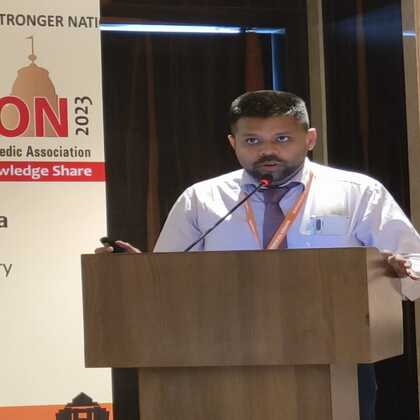Swelling can happen in any part of the leg, including the feet, calves, ankles, and thighs. It usually occurs when fluid builds up in the leg, known as fluid retention, and can also be caused by inflammation in damaged tissues or joints.
In most cases, leg swelling generally occurs due to common reasons like an injury or standing or sitting for a long time. These causes are usually not serious. However, sometimes swelling may be a sign of a more critical condition, such as heart disease or a blood clot. Keep reading to learn more about its causes and treatments.
Symptoms of Swelling in Legs
Some of the major symptoms of leg swelling include:
Legs appear larger than the previous day.
Stretched and shiny skin over the swollen area.
Difficulty in walking if the swelling affects the legs, ankles, or feet.
Coughing or trouble breathing.
A sensation of pressure or tightness in the affected swollen leg.
Mild pain or soreness in the affected part.
Seek medical help immediately if there is:
Pain or a change in skin colour in a swollen area
Shortness of breath
An open sore in the affected area
Swelling in only one limb.
Medical Causes of Leg Swelling
After diagnosing leg swelling, a healthcare provider will find out what is causing fluid to build up in the tissues. There can be several possible reasons, including:
Sitting or standing for too long causes fluid to collect in the legs.
Weak valves make it hard for veins to push blood to the heart, leading to varicose veins and leg swelling.
Heart, liver, kidney, lung, or thyroid diseases can cause fluid buildup.
Some drugs, such as those for blood pressure or pain, can also lead to swelling.
A diet high in salt or lacking balance can even cause fluid retention.
The growing uterus during pregnancy also puts pressure on blood vessels, leading to leg swelling.
Allergic reactions, burns, infections, trauma, or blood clots can even trigger swelling in the leg.
Lifestyle Factors Contributing to Leg Swelling
Apart from medical conditions, there are several lifestyle factors that can lead to leg swelling:
High salt intake results in fluid buildup, which can lead to swelling in the legs.
Having a sedentary lifestyle that involves sitting for long durations.
Implementing lifestyle changes like moderating salt intake, staying active and regular exercise can be effective prevention measures.
Immediate Remedies for Leg Swelling Relief
Here are some immediate tips that may help reduce leg swelling:
Keep the swollen area elevated above heart level several times a day to improve circulation. In some cases, elevating it while sleeping may also help.
Eat a diet low in salt to help prevent fluid retention.
Wear support stockings, available at most pharmacies and medical stores.
Avoid tight clothing or garters around the thighs.
Apply a cold compress to the swollen area to help reduce swelling and discomfort.
Do not stop taking any medication without consulting a healthcare provider.
Long-term Strategies to Prevent Swelling in Legs
Here are some self-care and long-term strategies to help prevent or reduce leg swelling:
Eat a healthy diet by avoiding processed and packaged foods that are high in salt.
Maintain a healthy weight if necessary.
Stay active and do regular exercise to help move excess fluid back to the heart.
Avoid sitting or standing for too long, and take breaks to move, especially during travel.
Quit tobacco and alcohol to support overall health.
Medical Treatments and Interventions for Swelling in Legs
Medicines and therapies that help the body remove excess fluid and improve circulation can be used to treat severe leg swelling. Some common treatments include:
Diuretics (Water Pills): Help the body get rid of extra fluid and are often used for swelling caused by heart failure or liver disease.
Compression Stockings: Tight-fitting stockings that improve circulation and reduce swelling in the legs.
NSAIDs (Nonsteroidal Anti-Inflammatory Drugs): Help reduce leg swelling and pain.
Anticoagulants: It is used if swelling is due to a blood clot, preventing it from getting worse.
Vasodilators: Help widen blood vessels and improve blood flow while reducing leg swelling.
Physical Therapy: Includes massage and exercises to improve circulation and reduce swelling.
Pneumatic Compression Pump Therapy: Uses air-filled jackets to provide intermittent and sequential compression, especially helpful for lymphatic oedema. This treatment is often followed by wearing graduated compression stockings.
Surgery: In severe cases, surgery may be needed to remove a blood clot, repair damaged veins, or treat the underlying cause of swelling.
It is important to consult a healthcare specialist before starting any treatment, as identifying the cause of swelling helps choose the appropriate procedure.
Complementary and Alternative Approaches for Leg Swelling
Swelling in the legs or other limbs can occur due to excess fluid buildup under the skin. Some self-care steps that may help reduce water retention include:
Herbal Remedies
Over-the-counter remedies with ammonium and caffeine or herbal diuretics such as goldenrod, horsetail, corn silk, dandelion, or juniper may help the body remove excess fluid.
Supplements containing natural plant pigments, such as 2,000 mg of hydroxyethylrutosides per day or a combination of 900 mg of diosmin and 100 mg of hesperidin, may help reduce oedema linked to venous or lymphatic conditions.
For swelling caused by venous or lymphatic disorders, taking 300 to 450 mg of butcher’s broom extract daily, along with hesperidin and vitamin C, may be beneficial.
Note: It is recommended to consult a healthcare professional before using any supplements or medications to ensure they are safe and appropriate for individual needs.
Massage and Acupuncture
Healthcare providers often recommend massage therapy to improve circulation, reduce fluid buildup, and relieve discomfort in swollen areas. Gentle lymphatic drainage massage is particularly beneficial for people with lymphedema.
Acupuncture is a traditional Chinese therapy that involves the insertion of fine needles at specific points on the body. It is believed to help with fluid balance and improve circulation.
Note: These procedures must be performed by trained professionals and used alongside the recommended medication.
Monitoring and Regular Checkups for Swelling in Legs
It is important to visit a healthcare provider if leg swelling or oedema occurs. If left untreated, the swelling can stretch the skin and may even lead to more serious health issues.
Legs swelling can be temporary or long-lasting, depending on its cause. Treatment options are available to manage underlying conditions, and simple lifestyle changes can also help reduce fluid buildup.
A person can also prepare a swelling diary to keep a track record of their health evaluation, including:
Check for Special Instructions
When scheduling the appointments, ask if any preparations are needed, such as fasting before tests.
Track Symptoms
Write down all symptoms, even those that may not seem related, and note when they started.
List Medical Information
This list mainly includes details of existing health conditions and a list of all medications, vitamins, and supplements with their doses.
Prepare Questions
Make a list of questions to ask the doctor, and bring a notebook or recorder to note the answers.
Take Photos
If swelling worsens at night, taking pictures on the phone can help the doctor assess the severity of the condition.
Conclusion
Leg swelling is a common condition, and its severity varies depending on the cause. Swelling is usually normal during pregnancy, especially as the due date approaches. In mild cases, it sometimes gets cured on its own, while more severe cases may require medication or treatment.
However, leg swelling may be a sign of an underlying health issue, and early diagnosis and treatment can help ensure the best outcome.
Consult Top Orthopaedician
Consult Top Orthopaedician
Dr. Anil Sharma
Orthopaedician
42 Years • MBBS, MS Orthopedics
New Delhi
AAKASH MEDSQUARE, New Delhi

Dr. Sourav Kumar Pal
Orthopaedician
3 Years • MBBS, MS(ORTHO)
Malda
B S ORTHO, Malda
Dr. Vamsi Krishna Reddy
Orthopaedician
6 Years • MBBS, M.S.Orthopaedics
Guntur
Sri Krishna Orthopedic And Dental Hospital, Guntur

Dr. Manoj Dinkar
Orthopaedician
15 Years • MBBS, Dip (Orthopaedics)
New Delhi
THE DOCTORS NESST, New Delhi

Dr. Mriganka Ghosh
Orthopaedician
11 Years • MD (Physician), DNB (Orthopaedics)
Howrah
Dr Mriganka Mouli Ghosh, Howrah

